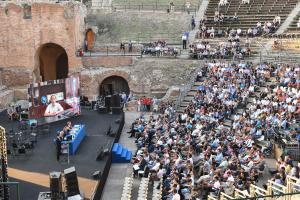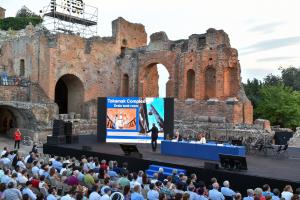Conference opens in antique setting
The ancient theatre of Taormina, in northeast Sicily, was built by the Romans on the foundations of an earlier Greek theatre. Still used to this day, the round structure normally resonates with the sound of opera or other performances. On Sunday 16 September, however, the historic monument provided a magnificent setting for quite a different event—the opening of the 30th Symposium of Fusion Technology (SOFT), the largest fusion technology conference in Europe.
This year's gathering was organized by the Italian National Agency for New Technologies, Energy and Sustainable Economic Development, ENEA. With close to 1,000 participants and more than 1,000 contributions it is looking to be a record-setting year in the history of the symposium. For conference chair Aldo Pizzuto from ENEA, these numbers—along with the ever-increasing participation of young researchers and the consolidated representation of industry representatives—illustrate the importance of SOFT as a platform for exchange on recent progress in fusion research and technology.
Asked what needed to be done to ensure the continuity of the project, Bernard Bigot stressed the importance of preparing the best scientists and engineers for the operation of ITER. "We need to motivate young people to become the next generation of fusion experts by giving them the flavour of fusion," he advised. He shared the enjoyment he felt during weekly Skype conversations with the young fusion aficionados who contacted him.
At the end of the opening ceremony, the ancient theatre returned to cultural performance function, entertaining conference participants with music by Italian composers performed by the Plectrum Orchestra of Taormina.
SOFT continues through 21 September.



